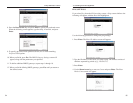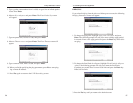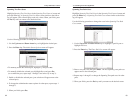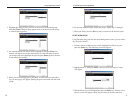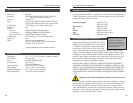
Linksys EtherFast
®
II Series
Appendix
As the demand for desktop video, multimedia development, imaging, and
other speed-intensive applications continues to rise, the need for high per-
formance, fault tolerant LAN technology will become more critical.
Standard Ethernet, which has been the most popular networking technology
to date with a maximum data throughput of 10Mbps (Megabits per second),
is becoming insufficient to handle the latest video, multimedia, and other
speed-intensive client/server LAN applications.
Among the solutions to the problem of network speed, Fast Ethernet has
emerged as the most viable and economical. Capable of sending and receiv-
ing data at 100Mbps, it is more than fast enough to handle even the most
demanding video and other real-time applications.
Although there are a number of different competing Fast Ethernet implemen-
tations, 100BaseTX is by far the most popular. Operating on two pairs of
Category 5 unshielded twisted-pair (UTP) cabling, 100BaseTX supports high
speed signaling and is relatively inexpensive. Because it uses four wires for
data transmission and the same packet format, packet length, error control,
and management information as 10BaseT, 100BaseTX can be made to com-
municate with slower 10BaseT equipment when routed through a switch.
This backwards compatibility is one of 100BaseTX's major advantages over
other forms of Fast Ethernet; it allows critical, speed-dependent network seg-
ments to be upgraded to 100BaseTX speeds as needed without re-wiring,
refitting, and retraining an entire site. Networks can now mix both slow and
fast network segments for different users or departments. Publishing, R&D,
video, multimedia, or accounting departments can enjoy a 100Mbps pace,
while other corporate segments can operate at slower and more affordable
10Mbps speeds.
78
About Fast Ethernet
10/100 Managed 24-Port GigaSwitch
Gigabit Ethernet runs at speeds of 1Gbps (Gigabit per second), ten times
faster than 100Mbps Fast Ethernet, but it still integrates seamlessly with
100Mbps Fast Ethernet hardware. Users can connect Gigabit Ethernet hard-
ware with either fiber optic cabling or copper Category 5 cabling, with fiber
optics more suited for network backbones. As the new Gigabit standard grad-
ually integrates into existing networks, current computer applications will
enjoy faster access time for network data, hardware, and Internet connections.
Fiber optic cabling is made from flexible, optically efficient strands of glass
and coated with a layer of rubber tubing, fiber optics use photons of light
instead of electrons to send and receive data. Although fiber is physically
capable of carrying tetrabits of data per second, the signaling hardware cur-
rently on the market can handle no more than a few gigabits of data per sec-
ond.
Fiber cables come in different with two main connector types. The most com-
monly used fiber optic cable is multi-mode fiber cable (MMF), with a 62.5
micron fiber optic core. Single-mode fiber cabling is somewhat more effi-
cient than multi-mode but far more expensive, due to its smaller optic core
that helps retain the intensity of traveling light signals. A fiber connection
always require two fiber cables: one transmits data, and the other receives it.
Each fiber optic cable is tipped with a connector that fits into a fiber port on
a network adapter, hub, or switch. In the U. S., most cables use a square SC
connector that slides and locks into place when plugged into a port or con-
nected to another cable. In Europe, the round ST connector is more prevalent.
79
About Gigabit Ethernet
Fiber Optic Cabling



